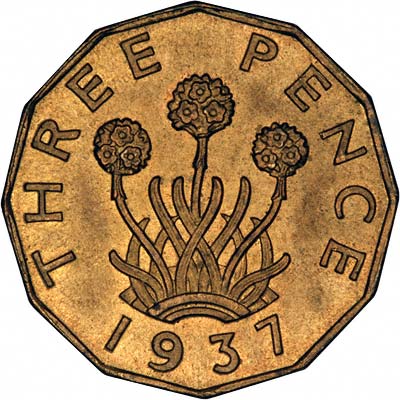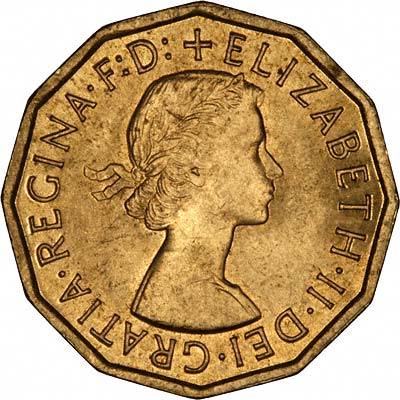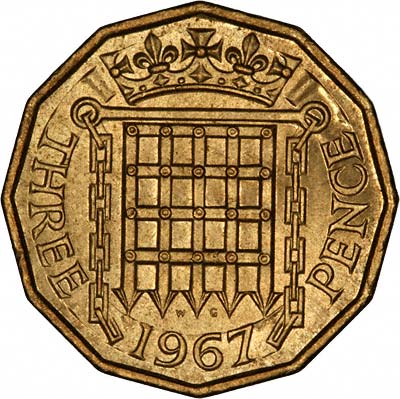| The Very Highest Quality Brass Threepences... |
| Brass Threepence Story |

|
|
|

|
|
|

|
|
|

|
|
|
1937 - 3 Different Threepences
In 1937, there were three different types of threepences issued. We tell the story of the silver threepence on its own page. There was also a Maundy silver threepence issued in 1937 using the previous design of the original silver threepence, but the new brass threepence was about to replace the silver version within a few years.
In 1937, a new design was introduced for the silver threepences of George VI, and at the same time a new brass alloy was used for the new twelve sided brass threepences. Silver threepences continued to be issued until 1944.
Brass Threepences
The new brass threepence quickly displaced the older silver coins which were felt to be rather small to be handled easily, and also were quite easily bent. The new brass alloy should correctly be called a nickel-brass alloy, as it does contain nickel.
The new coin broke fresh ground as it had many original features. It was the first British coin to be struck in nickel-brass, the first twelve sided or dodecagonal coin, and the first to use the thrift plant in its design.
Too Much Bronze
There were several reasons for the issue of the new brass threepence. According to C. Wilson Peck, in his monumental book "English Copper Tin and Bronze Coins in the British Museum 1558 - 1958", the weight of bronze coins being handled daily had grown too much. Large businesses, such as banks and transport companies were handling ever growing numbers of bronze coins. London Transport handled over 600 tons annually.
It was considered impracticable to reduce the weights of the existing bronze coins because of the length of time this would have taken, and presumably also the cost.
Most people used to, and still continue to, incorrectly call our bronze coins copper, which has not been used since 1860.
Silver Threepence Too Small
It was realised that the existing silver threepence was unpopular not because of its denomination, but because its small size made it difficult to handle.
Because silver threepences were also quite thin, they easily became bent, which would have been another contributory factor in their unpopularity.
A New Coin Alloy
The chosen solution was to issue a larger threepence, which obviously could not be made in silver because of its relatively high cost. A smaller bronze coin may have failed because being smaller than the lower valued pennies and halfpennies, it would not appeal psychologically. By using a gold-coloured alloy, a higher value could be suggested compared with bronze.
The composition of the new coin was to be 79% copper, 20% zinc,and 1% nickel. the addition of the small amount of nickel would have made the alloy harder, and was intended to make the coin more resistant to tarnishing.
New Shape - New Size
One very important aspect of any new coin is that it should be easily distinguishable from all other coins already in circulation. The new brass threepence was also intended to be lighter than the existing bronze coins which it was to partially replace.
Because of this its diameter at 21.0 mms across the flats and 21.6 mms across the points, was midway between that of the sixpence at 19.3 mms and shilling at 23.59 mms, and much smaller than the penny or halfpenny which were 30.81 and 25.47 mms respectively. The farthing was only slightly smaller at 20.16 mms.
What About the Weight?
Trial pieces in existence range from under 70 grains (4.536 grams) to about 101 grains (6.545 grams) and about 1.5 mms thick, but apparently only shortly before production began, it was found that the new coins would actuate sixpenny and shilling slot machines, and as a result the version which went into circulation was struck on a thicker flan at 2.25mms, and weighing 105 grains (6.804 grams).
The Thrift Plant
The design selected for the reverse of the new coin was that of a thrift plant, sometimes called a sea-pink. It was an adaptation of a design originally intended for the silver threepence, by Miss Frances Madge Kitchener. This reverse design continued in use until the end of George VI's reign in 1952.
Edward VIII
It may seem strange to list Edward VIII after George VI, but Edward abdicated in December 1936, after several hundred dies had already been prepared. Because of his abdication, no coins bearing his portrait were issued for circulation. Several denominations were issued bearing his name for countries such as British West Africa, these are quite common, so there is no need for excited individuals to contact us claiming to have found a rare Edward VIII coin. No British coins were issued for circulation. A small number of coins, mainly patterns or proofs, have found their way onto the market, and being rare, do command quite high prices. Of these, the threepence is probably the commonest, if that is the correct word, as a number of them were supplied to coin equipment manufacturers, presumably on loan, so that machines could be tested with the new coin. Obviously a number of these were never returned after testing. The writer, Lawrence Chard, has a vague but persistent memory of being shown one of the Edward VIII brass threepences many years ago, this was before I entered the coin business, but I can recall the design differences on both sides of the coin. The coin in question was owned by an amusement machine manufacturer or operator, and at the time my parents and grandparents owned a "penny arcade" on Blackpool's famous Golden Mile, and the coin was shown to us in the office at the rear of our premises.
Elizabeth II
For Elizabeth II, the reverse design of the brass threepence was changed to a crowned portcullis, originally a badge of Henry VII.
Because of decimalisation, the last threepence issued was dated 1967, although they were produced for a few years afterwards, the date was frozen at 1967 to discourage coin collecting! (hoarding, actually). After the 31st August 1971, brass threepences were demonitised.
1970 Farewell
Although, as we have said above, the last dated brass threepence to be issued for circulation was 1967, the Royal Mint produced a souvenir proof set of £.s.d coins, all dated 1970, and this obviously contained a brass threepence.
Coming Soon...
Stock List of Threepences, by Type
Stock List of Threepences by Date
Order Form - UK
Order Form - USA
Order Form - EU
Order Form - Rest of World
If you have an enquiry about any of our Threepences, we'd be happy to answer you, but please note it may be quicker to telephone us. Please see the Contact Us page of our website.
.
There are more answers to be found on our Frequently Asked Coin Questions page.
| ...at the Lowest Possible Price |
|
32 - 36 Harrowside, Blackpool, Lancashire, FY4 1RJ, England. Telephone (44) - (0) 1253 - 343081 ; Fax 408058; E-mail: The URL for our main page is: https://24carat.co.uk | Chard(1964) Ltd |